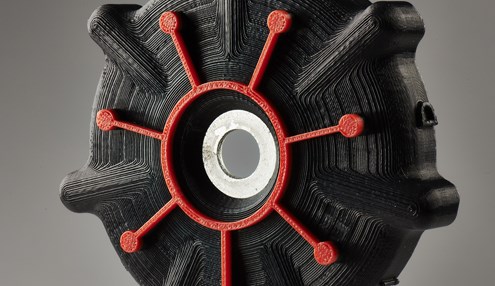At Stratasys Direct Manufacturing, the build volume of a 3D printer doesn’t scale down the size possibilities of parts. Our expert assemblers have precise methods curated over decades to make multiple components of a part that seamlessly align for a large assembly.
Some of those assembly methods include fasteners like nuts, bolts and threaded rods. It’s also common to attach fasteners to parts using a process like heat staking. Assembled Fused Deposition Modeling (FDM) components can benefit from hardware added in the middle of the build.
FDM machines can be paused in the middle of the build process, allowing technicians to add hardware into a specific layer or a pre-designed cavity, before resuming the build. To use mid-build inserts, a technician pauses the FDM machine and applies a clear coat to the surface of the insert, creating a tacky surface for the thermoplastic to adhere to. FDM is the only 3D printing process that allows for the adding of inserts directly into the in-build part.
Elimination of Secondary Operations
When you are building multiple parts for an assembly, adding hardware in the middle of the build allows the components to be put together as soon as they come off of the machine. This eliminates any secondary operations that can add to turn-around times.
Increase of Part Strength
FDM parts are built with engineering-grade thermoplastics, but sometimes applications require additional durability and strength. Hardware like metal rods can be inserted into parts to reinforce the thermoplastic material and increase overall part strength.
Addition of Large Hardware
For some automotive and aerospace applications, large washers, nuts and other hardware are required for assembly. Due to the size, these can often be difficult to heat stake into a component, the more traditional approach. By firmly embedding the large hardware inside the thermoplastic mid-build, the specialized inserts have the support needed to hold up in a more robust application.
Mid-build inserts for FDM assemblies require some planning. Elements to consider include:
The professional assembly services at Stratasys Direct can enhance what a designer, engineer and product team can do with 3D printing. FDM mid-build inserts streamline and improve upon the assembly process and offer streamlined possibilities for new parts.

